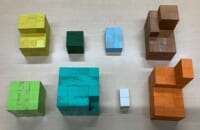今日11月17日を4ケタの数で表すと、1117は素数です。西暦を含めた20191117も 素数です。
 今回は、数学者の谷克彦さんが数学博物館へ寄贈してくださった著書「美しい幾何学」(2019 技術評論社)の中から、正多面体についての内容をご紹介します。
今回は、数学者の谷克彦さんが数学博物館へ寄贈してくださった著書「美しい幾何学」(2019 技術評論社)の中から、正多面体についての内容をご紹介します。
中学1年生で、正多面体は5種類しかないことを学習します。授業では、頂点に着目して図形的に確認しています。詳しくは、ブログ#44『正多面体は5種類しかない!』、#45『正多面体は5種類しかない!2』を見てくださいね。
正多面体が5種類しかないことは、実は「オイラーの多面体公式」を利用して計算で説明できます。式に文字を使い、テクニックを使って式を変形していきます。2回に分けて説明していきます。

(1)まず、「オイラーの多面体公式」を紹介します。ある条件をクリアした立体(多面体)は、
(面の数)+(頂点の数)-(辺の数)= 2 ・・・①
となることがわかっています。例えば、直方体であれば、「6+8-12 = 2」となっています。
(2)次に、正多面体の性質を考えていきます。正多面体はそれぞれの面の多角形が合同で、頂点に集まる面の数が等しいという特徴があります。面の形をp角形(pは3以上の整数、2角形はできないから)、頂点に集まる面の数をq(qは3以上の整数、2枚で頂点は作れないから)とすると、
(ⅰ)p×(面の数)=(辺の数)×2
したがって、
(面の数)=(辺の数)×2/p ・・・②
(ⅱ)q×(頂点の数)=(辺の数)×2
したがって、
(頂点の数)=(辺の数)×2/q ・・・③
今回は、面の数、頂点の数、辺の数について3つの式を知りました。次回は、3つの式を使って、正多面体が5つしかない理由を発見しましょう! 皆さんも考えてみてください。
(数学科 園田毅)
“Only 5 kinds of Regular polyhedron! 3”
Mathematician Tani Katsuhiko san donated his book to our museum and I will introduce the content about regular polyhedrons in his book.
The 7th grade students learn that there are only 5 kinds of regular polyhedron. I explain the reason of the theory graphically thinking about the number of vertex. Please refer to our blog #44“Only 5 kinds of Regular polyhedron! ” and #45 “Only 5 kinds of Regular polyhedron! 2” for details. I will find this theory by calculation using “’Euler’s polyhedron formula”. We make expressions to complete the formula using characters and techniques, so it may be little difficult for junior high school students.
(1) First, this is the “Euler’s polyhedron formula” below. Solids that have some contents always have characters.
(the number of faces)+(the number of vertices)-(the number of sides)=2 ・・・①
For example, in the case of the rectangle parallelepiped,
“6+8-12=2” is established.
(2)Next, let’s think about characteristics of regular polyhedron. Regular polyhedron have 2 features, one is that all are regular polygons, the other is that the number of faces gathering at a point are same. When the shape of regular polygons is “p” (p is an integer greater than or equal to 3) and the number of faces is “q” (q is an also integer greater than or equal to 3),
(ⅰ) p×(the number of faces)=(the number of sides) ×2
Then
(the number of faces)=(the number of sides) ×2/p ・・・ ②
(ⅱ) q×(the number of vertices)= (the number of sides)×2
Then
(the number of vertices)= (the number of sides) ×2/p ・・・ ③
We can have 3 relational expressions now.
Let’s get a solution by the next blog and try thinking!
by Tsuyoshi Sonoda (Math Dept.)



